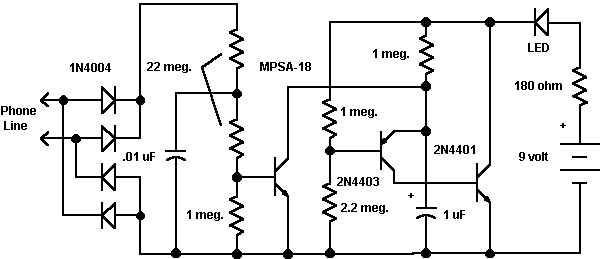|
When a new computer modem enters the household, the demands on the home phone line skyrockets. The Internet surfer can use phone time on a par with the most talkative teenager. And the computer modem user can be quite sensitive about his privacy: simply lifting another receiver can knock him off-line causing emotional stress. The phone wiring may be modified so that the modem is always in control by connecting the phone line directly to the modem and connecting the rest of the phones to the modem's "phone" jack. But this solution gives the computer user too much power over the phone line and it doesn't solve the problem if two computers share a single line. Here is a simple blinking LED circuit which will alert users when the line is in use before the receiver is lifted. The circuit loads the phone line so lightly that it meets the on-hook telephone equipment leakage specification and the short lamp flashes draw very little current from the nine-volt battery. One of these devices may be placed at each extension without significantly loading the phone line. The circuit is connected to the red and green wires for a single-line system or the yellow and black wires for the second line in a two-line system. Polarity doesn't matter, thanks to the full-wave rectifier. In order to preserve your phone line balance, do not power this device from a line-powered power supply. Only use a battery as shown and insulate the battery and circuitry by building the device into a plastic case. Do not ground the circuitry. The circuit will work with other batteries and battery voltage. Four AA, C, or even D cells (6 volts) will last considerably longer if you have teenagers burning up your batteries. A small 9-volt rectangular battery will be fine for most users.
Notes:
| The diode bridge eliminates polarity concerns. It may be left out but the wires to the phone line may need to be reversed if the circuit doesn't work properly. | |
| The 22 megohm resistors are sufficiently high to meet phone circuit leakage specifications. | |
| A 2N4401 will usually work in place of the MPSA-18 but if the transistor gain is too low the flashing will not stop. ref: techlib.com/electronics/telephone.html |



0 comments:
Post a Comment